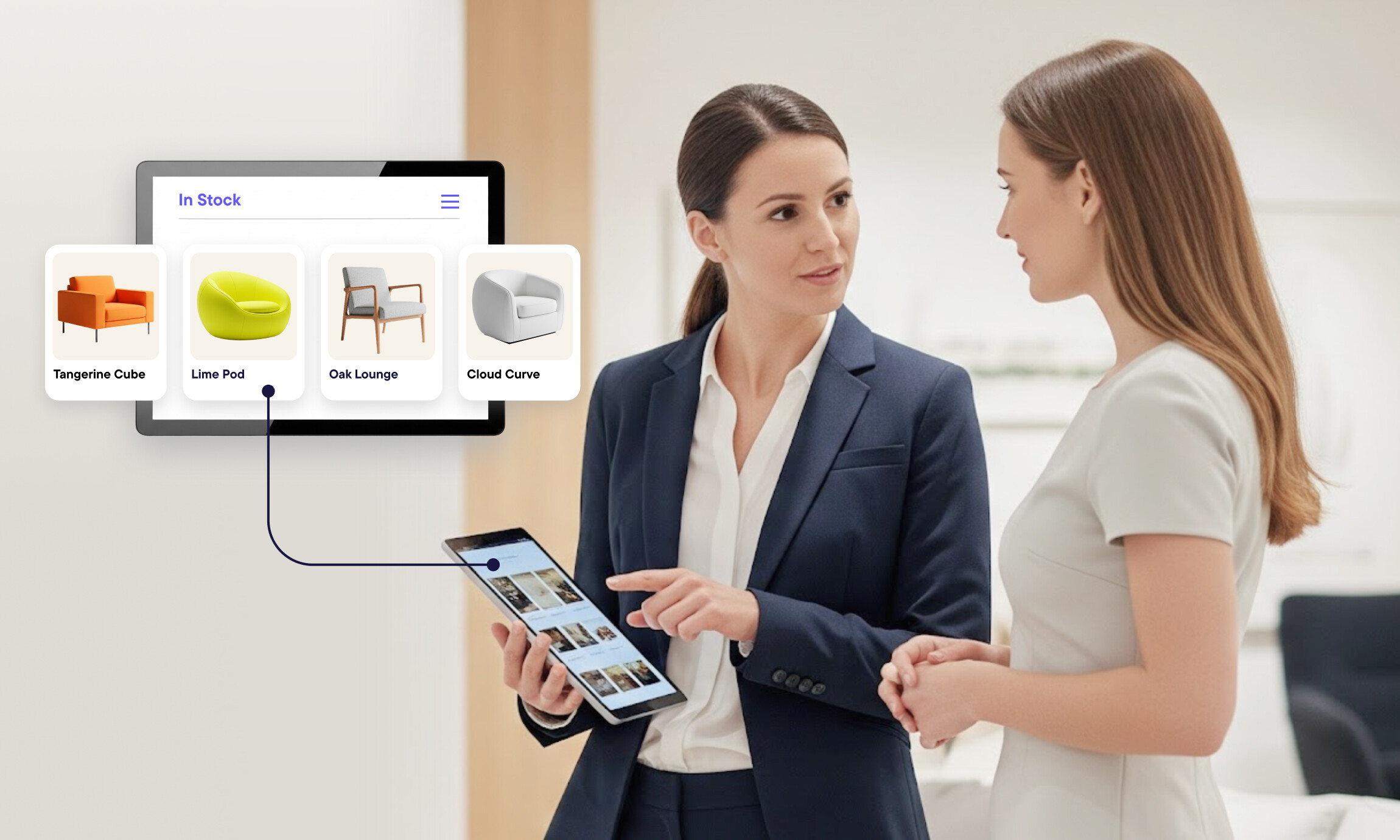
What you’ll learn:

Elevating customer experiences starts with empowering the front line
Elevating customer experiences in retail has never been more critical. In a fiercely competitive market, retailers invest millions in technologies promising to make shopping faster and more enjoyable. Yet, one crucial voice is often overlooked in these investments: The store associate.
Store associates, the frontline workers who engage directly with customers, are the backbone of every brick-and-mortar experience. They help customers find products, offer recommendations and even advice. In today’s increasingly complex retail operations, store associates also need to check whether products are available in stock, deal with returns and refunds, support omnichannel fulfillment workflows, such as BOPIS, manage returns and track online orders. And so on.
Their role has expanded rapidly, yet their tools haven’t always kept pace.
With 63% of frontline retail workers citing task completion as their top success metric, empowering them with the right tools and data is crucial. Unfortunately, many still face daily challenges: Outdated systems, inconsistent pricing across channels and limited access to inventory or customer history. These inefficiencies create frustration for both associates and customers.
The underlying cause? Underinvestment in store associate technology:
73% of frontline retail workers are dissatisfied with the technology provided by their employers, as workers claim there’s a need for improvement in tools and systems to help them enhance their job quality, efficiency and access to information.
40% of retail workers feel that their employers don’t invest in their tech needs, with 20% actively feeling that it’s a non-priority.
While 75% of corporate leaders believe their organizations are investing in technology for frontline teams, only 39% of frontline employees agree.
This disconnect highlights a paradox: Retailers overinvest in customer-facing tech while neglecting the very people who deliver those experiences.
To truly elevate customer experiences, retailers must empower their store associates through three key pillars: Unified data access, systematic feedback collection and dynamic training.
Nothing is more frustrating for customers than stepping into a store, engaging with an associate and getting no answer to a simple inquiry, such as these examples:
Can I return this product I ordered online — without a receipt?
Can I order this product in-store and have it delivered to my home? (relevant for large items, e.g., furniture).
What else should I order to complete my project? (relevant for project-related sales, e.g., building and renovation materials).
On the surface, answering those queries shouldn’t be difficult. And yet, most customers leave the store empty-handed.
For store associates, this is equally frustrating. The problem? Fragmented systems. Store associates often rely on outdated or siloed platforms, making it nearly impossible to retrieve real-time inventory, pricing or order information. Often, it’s not the associate’s fault — they simply don’t have the data they need in one place.
As brick-and-mortar sales continue to increase and are projected to reach $28.3 trillion by 2030, retailers have a strong business case for investing in unified data solutions.
With unified commerce, all data (customer profiles, inventory, pricing, promotions) lives in one place, empowering associates to:
Offer personalized recommendations based on customer history.
Track and manage omnichannel orders and returns seamlessly.
Help customers complete purchases or projects with guided selling to meet specific needs, such as buying all the items in back-to-school supply lists.
This unified commerce approach enables retailers to connect online logic to in-store sales, ensuring that both touchpoints become complementary rather than competing with each other.
For example, Jaycar, an Australian electronics retailer, enables associates to view unified shopping lists for projects like solar panel installations. This lets associates suggest complementary products, increasing both customer satisfaction and basket size. This also helps store associates guide customers with a history of repeat purchases.
Furthermore, while online basket sizes are typically larger due to product content and recommendations and discount prompts, having consistent communication of discounts in-store can also drive incentivized behavior and increased in-store basket sizes. Finally, retailers can, for the first time, take the personalized experiences offered online and translate them into a physical store setting.
The result: Boost solutions that increase shopper satisfaction and loyalty while lifting profitability in their brick-and-mortar stores.
Frontline associates hold a goldmine of customer insights. They hear what shoppers want, what frustrates them and where processes break down. Yet, their voices are rarely captured systematically.
Studies show that employee involvement in service improvements is directly correlated with higher customer satisfaction and increased employee commitment. In some cases, involving frontline staff in feedback sessions improves client approval ratings by up to 30%.
Interestingly, many retailers have implemented feedback loops in their contact centers, making it easy for customer service reps (as well as AI-based agents) to surface customer feedback as a means to continuous improvement. However, the implementation of feedback programs hasn’t yet reached employees working in brick-and-mortar stores.
So, why isn’t the valuable feedback coming from store associates taken into account?
Retailers with a footprint of hundreds — or sometimes thousands — of stores need a systematic way to collect and analyze feedback. In many cases, we’re talking about thousands of employees spread across multiple cities, regions or countries. Bringing ideas from frontline workers to decision-makers in headquarters isn’t possible unless there’s a way to connect in-store technology with solutions that capture feedback without hassle.
However, the in-store technology most retailers use today is the POS (point-of-sale) system. Designed as a transactional tool that works in the confines of the store, the POS system’s objective is simple: To process a purchase. Integrating other tools on top is usually difficult due to the POS’s limited scope and inflexible infrastructure.
A unified commerce approach helps retailers tap into the feedback from store associates, because this infrastructure enables the seamless integration of lightweight solutions to collect, analyze and act on behavioral data, as well as capture feedback for process enhancements.
This creates a structured, scalable way for associates to share insights — and for headquarters to act on them.
The retail industry is well-known for its high rates of employee turnover. In the US, the average turnover rate is around 60%. The high churn is driven by factors like poor communication, feelings of isolation and burnout — as well as limited training.
Providing training and support is more than just a way to address retail’s high churn rates. When store associates are properly trained — and have access to unified data and adequate tooling — they feel confident in dealing with complex inquiries, which, in turn, translates into experiences that keep customers coming back.
However, keeping store associates trained across a variety of scenarios, from returns to BOPIS, in a constantly changing workforce isn’t easy. Retailers need digital solutions that empower associates to learn on their own — and on the fly.
Say that a store associate needs to perform a product exchange and doesn’t know what the steps are. Having an on-screen process walkthrough immediately available would facilitate the process for both the associate and the customer, who wouldn’t need to wait ages until the employee is familiar with the process or asks a more senior colleague.
Providing training information and product walkthroughs can be easily done with a browser-based solution. This means retailers can enable store associates to keep up with new processes with solutions that can provide pop-up notifications, in-app help tags, built-in training flows and personalized training paths for new employees or infrequent tasks like refunds — all available on the systems store associates already use.
With a composable foundation, retailers can integrate solutions directly into their unified commerce platform, empowering store associates to learn fast and act even faster. Combined with unified data, this empowers staff to perform efficiently and, more than ever, truly elevate customer experiences.
Smarter, just-in-time training reduces churn, builds confidence and turns complexity into consistency.
Giving your store associates a voice — and their mojo — back
Retailers can no longer afford to separate customer experience from employee experience. The two are deeply intertwined. Store associates serve as the vital link between digital intent and the physical experience.
By giving associates access to unified data, collecting their feedback and equipping them with continuous training, all powered by flexible unified commerce, retailers unlock a powerful competitive advantage: A workforce that feels empowered, informed and invested in delivering exceptional customer experiences.
With solutions like commercetools InStore, retailers can make this vision a reality — connecting digital and physical channels through a unified platform that empowers associates to deliver seamless, personalized experiences at every interaction. The solution unifies data, checkout, feedback and training in one intuitive interface, giving associates everything they need to operate efficiently and deliver seamless service.
Ultimately, the path to outstanding retail CX starts with the people who use it. Empower them — and you elevate everything.
